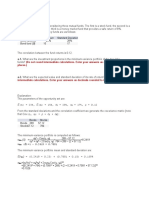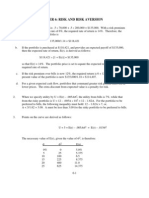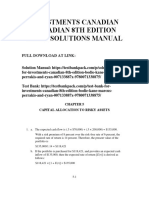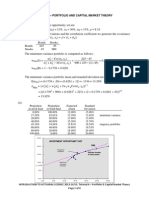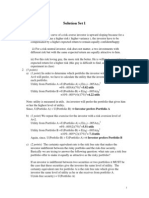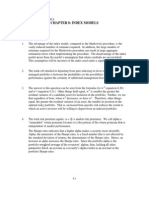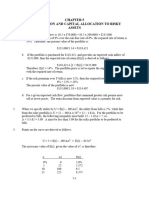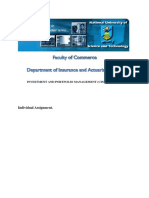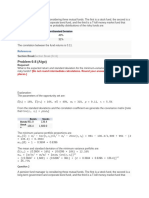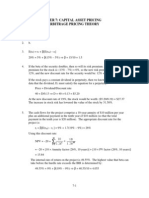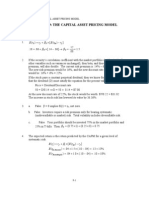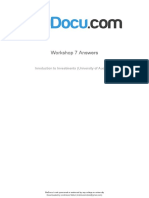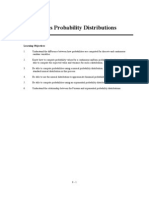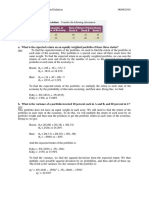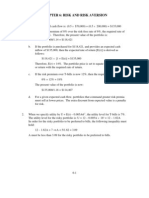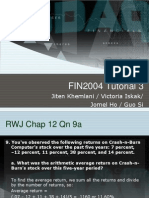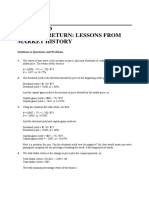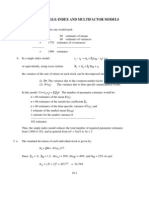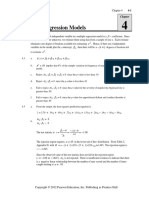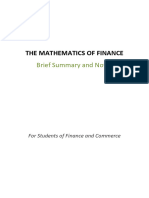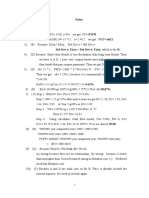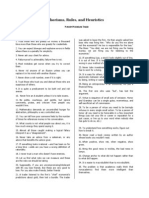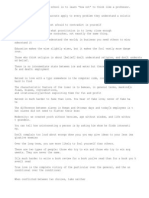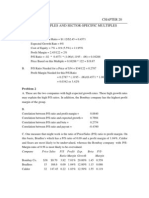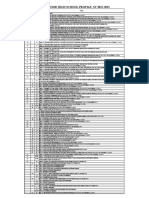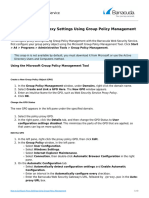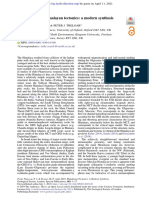Chapter 27: The Theory of Active Portfolio Management
Chapter 27: The Theory of Active Portfolio Management
Uploaded by
Silviu TrebuianCopyright:
Available Formats
Chapter 27: The Theory of Active Portfolio Management
Chapter 27: The Theory of Active Portfolio Management
Uploaded by
Silviu TrebuianOriginal Title
Copyright
Available Formats
Share this document
Did you find this document useful?
Is this content inappropriate?
Copyright:
Available Formats
Chapter 27: The Theory of Active Portfolio Management
Chapter 27: The Theory of Active Portfolio Management
Uploaded by
Silviu TrebuianCopyright:
Available Formats
CHAPTER 27: THE THEORY OF ACTIVE PORTFOLIO MANAGEMENT
1. a. Define R = r rf. Note that we compute the estimates of standard deviation using 4 degrees of freedom (i.e., we divide the sum of the squared deviations from the mean by 4 despite the fact that we have 5 observations), since deviations are taken from the sample mean, not the theoretical population mean. E(RB) = 11.16% B = 21.24% = .75 Risk neutral investors would prefer the Bull Fund because its performance suggests a higher mean. Given the estimates of the variance of the series and the small number of observations, the difference in the averages is too small to determine the superiority of Bull with any confidence. b. Using the reward to volatility (Sharpe) measure, SB = SU = = = .5254 = = = .5670 E(RU) = 8.42% U = 14.85%
The data suggest that the Unicorn Fund dominates for a risk averse investor. c. The decision rule for the proportion to be invested in the risky asset, given by the formula y= = maximizes a mean variance utility of the form, U = E(r) .005A2 for which Sharpe's measure is the appropriate criterion for the selection of optimal risky portfolios. In any event, an investor with A = 3 would invest the following fraction in Unicorn: yU = = 1.2727 Note that the investor wants to borrow in order to invest in Unicorn. In that case, his portfolio risk premium and standard deviation would be: E(rP) rf = 1.2727 8.42% = 10.72% , and his utility level would be: U(P) = rf + 10.72 .005 3 18.902 = rf + 5.36. 27-1 P = 1.2727 14.85% = 18.90%
If borrowing is not allowed, investing 100% in Unicorn would lead to: E(rP) rf = 8.42% P = 14.85% U(P) = rf + 8.42 .005 3 14.852 = rf + 5.11 Note that if Bull must be chosen, then: yB = = .8246 E(rP) rf = .8246 11.16% = 9.20% P = .8246 21.24% = 17.51% U(P) = rf + 9.20 .005 3 17.512 = rf + 4.60. Thus, even with a borrowing restriction, Unicorn (with the lower mean) is still superior. = 5.5%
2.
and
rf = 1%
Write the Black-Scholes formula from Chapter 21 as: C = SN(d1) PV(X) N(d2) In this application, where we express the value of timing per dollar of assets, we use S = 1.0 for the value of the stock; the present value of the exercise price also is 1. Note that: d1 = and d2 = d1 When S = PV(X), and T = 1, the formula for d1 reduces to d1 = /2 and d2 = /2. Therefore, C = N(/2) N(/2). Finally recall that N(x) = 1 N(x). Therefore, we can write the value of the call as: C = N(/2) [1 N(/2)] = 2N(/2) 1 Since = .055, the value is: C = 2N(.0275) 1.
27-2
Interpolating from the standard normal table (Table 21.2): C = 2[.5080 + ] 1 C = 1.0220 1 = .0220 Hence the added value of a perfect timing strategy is 2.2% per month. 3. a. Using the relative frequencies to estimate the conditional probabilities P1 and P2 for timers A and B, we find: Timer A Timer B P1 78/135 = .58 86/135 = .64 P2 57/92 = .62 50/92 = .54 P* = P1 + P2 1 .20 > .18 The data suggest that timer A is the better forecaster b. Using the following equation to value the imperfect timing services of A and B, C(P*) = C(P1 + P2 1) CA(P*) = 2.2% .20 = .44% per month CB(P*) = 2.2% .18 = .40% per month Timer A's added value is greater by 4 basis points per month. Alphas, i = ri [rf + i(rM rf) ] A = 20 [8 + 1.3(16 8)] = 1.6% B = 18 [8 + 1.8(16 8)] = 4.4% C = 17 [8 + 0.7(16 8)] = 3.4% D = 12 [8 + 1.0(16 8)] = 4.0%
a.
Expected excess return E(ri) rf 20 8 = 12% 18 8 = 10% 17 8 = 9% 12 8 = 4%
Stocks A and C have positive alphas, whereas stocks B and D have negative alphas. The residual variances are: 2(eA)= 3364 2(eB)= 5041 b. 2(eC)= 3600 2(eD)= 3025
To construct the optimal risky portfolio, we first need to determine the active portfolio. 27-3
Using the Treynor-Black technique, we construct the active portfolio
A B C D Total
.000476 .000873 .000944 .001322 .000775
.6142 1.1265 1.2181 1.7058 1.0000
Do not be disturbed by the fact that the positive alpha stocks get negative weights and vice versa. The entire position in the active portfolio will turn out to be negative, returning everything to good order. With these weights, the forecast for the active portfolio is: = .6142 1.6 + 1.1265 (4.4) 1.2181 3.4 + 1.7058 (4.0) = 16.90% = .6142 1.3 + 1.1265 1.8 1.2181 .70 + 1.7058 1 = 2.08 The high beta (higher than any individual beta) results from the short position in relatively low beta stocks and long position in relatively high beta stocks. 2(e) = (.6142)2 3364 + 1.12652 5041 + (1.2181)2 3600 + 1.70582 3025 = 21809.6 (e) = 147.68% Here, again, the levered position in stock B [with the high 2(e)] overcomes the diversification effect, and results in a high residual standard deviation. The optimal risky portfolio has a proportion w* in the active portfolio as follows: w0 = = = .05124 The negative position is justified for the reason given earlier. The adjustment for beta is w* = = = .0486 Because w* is negative, we end up with a positive position in stocks with positive alphas and vice versa. The position in the index portfolio is: 1 (.0486) = 1.0486 c. To calculate Sharpe's measure for the optimal risky portfolio we need the appraisal ratio 27-4
for the active portfolio and Sharpe's measure for the market portfolio. The appraisal ratio of the active portfolio is: A = / e = 16.90/147.68 = .1144 and A2 =.0131
Hence, the square of Sharpe's measure, S, of the optimized risky portfolio is : S2 = S+ A2 = ( )2 + .0131 = .1341 and S = .3662
Compare this to the market's Sharpe measure, SM = 8/23 = .3478 The difference is .0184. Note that the only-moderate improvement in performance results from the fact that only a small position is taken in the active portfolio A because of its large residual variance. We calculate the "Modigliani-squared", or M2 measure, as follows: E(rP*) = rf + SP M = 8% + .3662 23% = 16.423% M2 = E(rP*) E(rM) = 16.423% 16% = 0.423%
27-5
d.
To calculate the exact makeup of the complete portfolio, we need the mean excess return of the optimal risky portfolio and its variance. The risky portfolio beta is given by: P = wM + wA A = 1.0486 + (.0486)2.08 = .95 E(RP) = P + PE(RM) = .0486(16.90%) + .95 8% = 8.42% = + = (.95 23)2 + (.0486)2 21809.6 = 528.94 P = 23.00% Since A = 2.8, the optimal position in this portfolio is: y = = .5685 In contrast, with a passive strategy: y = = .5401 which is a difference of .0284. The final positions of the complete portfolio are: Bills M: A: B: C: D: 1 .5685 = .5685 l.0486 = .5685 (.0486)(.6142) = .5685 (.0486)(1.1265) = .5685 (.0486)(1.2181) = .5685 (.0486)(1.7058) = 43.15% 59.61 1.70 3.11 3.37 4.71 100.00
[sum is subject to rounding error]
Note that M may include positive proportions of stocks A through D.
27-6
5.
If a manager is not allowed to sell short he will not include stocks with negative alphas in his portfolio, so that A and C are the only ones he will consider.
A: C: 1.6 3.4
2(e) 3364 3600 .000476 .000944
.3352 .6648
.001420
1.0000
The forecast for the active portfolio is: = .3352 1.6 + .6648 3.4 = 2.80% = .3352 1.3 + .6648 0.7 = 0.90 2(e) = .33522 3364 + .66482 3600 = 1969.03 (e) = 44.37% The weight in the active portfolio is: w0 = = = .0940 and adjusting for beta: w* = = = .0931 The appraisal ratio of the active portfolio is: A = /e = 2.80 / 44.37 = .0631 and hence, the square of Sharpe's measure is: S2 = (8/23)2 + .06312 = .1250 and S = .3535, compared to the market's Sharpe measure SM = .3478. When short sales were allowed (problem 4) , the manager's Sharpe measure was higher, .3662. The reduction in the Sharpe measure is the cost of the short sale restriction. We calculate the "Modigliani-squared", or M2 measure, as follows: E(rP*) = rf + SP M = 8% + .3535 23% = 16.1305% M2 = E(rP*) E(rM) = 16.1305% 16% = 0.1305% 27-7
versus .423% when short sales were allowed. The characteristics of the optimal risky portfolio are: P = wM + wA A = 1 .0931 + (.0931 .9) = .99 E(RP) = P + PE(RM) = .0931 2.8% + .99 8% = 8.18% = + 2(eP)= (.99 23)2 + .09312 1969.03 = 535.54 P = 23.14% With A = 2.8, the optimal position in this portfolio is: y = = .5455 The final positions in each asset are: Bills M: A: C: 1 .5455 = .5455 (1 .0931) = .5455 .0931 .3352 = .5455 .0931 .6648 = 45.45% 49.47% 1.70% 3.38% 100.00%
b.
The mean and variance of the optimized complete portfolios in the unconstrained and short-sales constrained cases, and for the passive strategy are: E(RC) .5685 8.42 = 4.79 .5455 8.18 = 4.46 .5401 8.00 = 4.32 .56852 528.94 = 170.95 .54552 535.54 = 159.36 .54012 529.00 = 154.31
Unconstrained Constrained Passive
The utility level, E(rC) .005Ais: Unconstrained Constrained Passive 8 + 4.79 .005 2.8 170.95 = 10.40 8 + 4.46 .005 2.8 159.36 = 10.23 8 + 4.32 .005 2.8 154.31 = 10.16
27-8
6. a. The optimal passive portfolio is obtained from equation (8.7) in Chapter 8 on Optimal Risky Portfolios. wM = where E(RM) = 8%, E(RH) = 2% and Cov(rH,rM) = MH =.6 23 18 = 248.4 wM = = 1.797 and wH = .797 If short sales are not allowed, portfolio H would have to be left out of the passive portfolio because the weight on H is negative. b. With short sales allowed, E(Rpassive) = 1.797 8% + (.797) 2% = 12.78% = (1.797 23)2 + [(.797) 18]2 + 2 1.797 (.797) 248.4 = 1202.54 passive = 34.68% Sharpe's measure in this case is: Spassive = 12.78 / 34.68 = .3685 compared with the market's Sharpe measure of SM = 8 / 23 = .3478 c. The improvement in utility for the expanded model of H and M versus a portfolio of M alone is calculated below for A = 2.8. y = = .3796 Therefore, Upassive = 8 + (12.78 .3796) (.005 2.8 .37962 1202.54) = 10.43 which is greater than Upassive = 10.16 from problem 5.
27-9
7.
The first step is to find the beta of the stocks relative to the optimized passive portfolio. For any stock i, the covariance with a portfolio is the sum of the covariances with the portfolio components, accounting for the weights of the components. Thus, i = = Therefore, A = = .5621 B = = .8705 C = = .0731 D = = .7476
27-10
Now the alphas relative to the optimized portfolio are: i = E(ri) rf i,passive E(Rpassive) A = 20 8 .5621 12.78 = 4.82% B = 18 8 .8705 12.78 = 1.12% C = 17 8 .0731 12.78 = 8.07% D = 12 8 .7476 12.78 = 5.55% The residual variances are now obtained from: 2(ei; passive)= ( ) where = + 2(ei) from Problem 4. 2(eA) = (1.3 23)2 + 582 (.5621 34.68)2 = 3878.01 2(eB) = (1.8 23)2 + 712 (.8705 34.68)2 = 5843.59 2(eC) = (0.7 23)2 + 602 (.0731 34.68)2 = 3852.78 2(eD) = (1.0 23)2 + 552 (.7476 34.68)2 = 2881.80 From this point, the procedure is identical to that of problem 6:
A B C D Total
.001243 .000192 .002095 .001926 .001220
1.0189 0.1574 1.7172 1.5787 1.0000
The active portfolio parameters are: = 1.0189 4.82 + (0.1574)(1.12) + 1.7172 8.07 + (1.5787)(5.55) = 27.71% = 1.0189 .5621 + (0.1574)(.8705) + 1.7172 .0731 + (1.5787)(.7476) = 0.6190 2(e) = 1.01892 3878.01 + (0.1574)2 5843.59 + 1.71722 3852.78 + (1.5787)2 2881.80 = 22,714.03
27-11
The proportions in the overall risky portfolio can now be determined. w0 = = = .1148 w* = = .0968 a. Sharpe's measure for the optimal risky portfolio is S2 = S+ [/2(e)]2 = .36852 + = .1696 S = .4118 compared to Spassive = .3685 The difference in the Sharpe measure is therefore .0433. b. The beta of the optimal risky portfolio is: P = w*A + (1 w*) = .0968(0.6190) + .9032 = .8433 The mean excess return of this portfolio is: E(R) = .0968 27.71% + .8433 12.78% = 13.46% and its variance and standard deviation are: 2 = .84332 1202.54 + .09682 22714.03 = 1068.03 = 32.68% Therefore, the position in it would be: y = = .4501 The utility value for this portfolio is: U = 8 + (.4501 13.46) (.005 2.8 .45012 1068.03) = 11.03 which is superior to all previous alternatives.
8.
If short sales are not allowed, then the passive portfolio reverts to M, and the solution mimics the solution to problem 5.
27-12
9.
All alphas are reduced to .3 times their values in the original case. Therefore, the relative weights of each security in the active portfolio are unchanged, but the alpha of the active portfolio is only .3 times its previous value, .3 16.90% = 5.07%, and the investor will take a smaller position in the active portfolio. The optimal risky portfolio has a proportion w* in the active portfolio as follows: w0 = = = .01537 The negative position is justified for the reason given earlier. The adjustment for beta is w* = = = .0151 Because w* is negative, we end up with a positive position in stocks with positive alphas and vice versa. The position in the index portfolio is: 1 (.0151) = 1.0151 To calculate Sharpe's measure for the optimal risky portfolio we need the appraisal ratio for the active portfolio and Sharpe's measure for the market portfolio. The appraisal ratio of the active portfolio is .3 times its previous value: A = / (e)= 5.07/147.68 = .0343 and A2 =.00118
Hence, the square of Sharpe's measure of the optimized risky portfolio is : S2 = S+ A2 = ( )2 + .00118 = .1222 and S = .3495
Compare this to the market's Sharpe measure, SM = 8/23 = .3478 The difference is .0017. Note that the reduction of the forecast alphas by a factor of .3 reduced the squared appraisal ratio and improvement in the squared Sharpe ratio by a factor of (.3)2 = .09.
27-13
You might also like
- Dokumen - Tips Recipe Cards Master 2020 01-21-2019 Nestl Usa Inc All Rights ReservedDocument108 pagesDokumen - Tips Recipe Cards Master 2020 01-21-2019 Nestl Usa Inc All Rights ReservedSam Saiz100% (3)
- BKM Chapter 6 SolutionsDocument14 pagesBKM Chapter 6 SolutionsAhtsham Ahmad100% (3)
- Chapter7 Practice QuestionsDocument7 pagesChapter7 Practice QuestionsNoor TaherNo ratings yet
- ProblemSet9 Solutions v1Document7 pagesProblemSet9 Solutions v1s4mlauNo ratings yet
- Chap 7 Bodie 9eDocument13 pagesChap 7 Bodie 9eChristan LambertNo ratings yet
- Answer 3Document7 pagesAnswer 3Quân LêNo ratings yet
- Sample FRM Part 1Document6 pagesSample FRM Part 1Silviu TrebuianNo ratings yet
- Financial Book ListDocument3 pagesFinancial Book ListSilviu TrebuianNo ratings yet
- CFA Level 1 - Economics Flashcards - QuizletDocument20 pagesCFA Level 1 - Economics Flashcards - QuizletSilviu Trebuian100% (3)
- Chapter 7: Capital Allocation Between The Risky Asset The Risk-Free AssetDocument9 pagesChapter 7: Capital Allocation Between The Risky Asset The Risk-Free AssetjojoFRNo ratings yet
- Chapter 6: Risk and Risk AversionDocument8 pagesChapter 6: Risk and Risk AversionSilviu TrebuianNo ratings yet
- Single Factor and CAPMDocument56 pagesSingle Factor and CAPMpyaarelal100% (1)
- Investments Canadian Canadian 8th Edition Bodie Solutions Manual 1Document14 pagesInvestments Canadian Canadian 8th Edition Bodie Solutions Manual 1theresa100% (59)
- Homework IPM March 2016Document11 pagesHomework IPM March 2016Berry FransNo ratings yet
- Chapter 22 Solution To Problems 1Document3 pagesChapter 22 Solution To Problems 1Jayvee M FelipeNo ratings yet
- Act7 3Document6 pagesAct7 3Helen B. EvansNo ratings yet
- Solution Set 1: 2. (5 Points)Document9 pagesSolution Set 1: 2. (5 Points)c406400No ratings yet
- Solutions To Class Problems - Portfolio TheoryDocument7 pagesSolutions To Class Problems - Portfolio TheoryVivek MandalNo ratings yet
- PracticeQuestion CH 6&8Document13 pagesPracticeQuestion CH 6&8putinNo ratings yet
- Index Models: Problem SetsDocument14 pagesIndex Models: Problem SetsdomazzzNo ratings yet
- Risk and Return HW KeyDocument4 pagesRisk and Return HW Keyjorge scharffenorthNo ratings yet
- Chap 8 Bodie 9eDocument14 pagesChap 8 Bodie 9eChristan LambertNo ratings yet
- Bkm9e Answers Chap007Document12 pagesBkm9e Answers Chap007AhmadYaseenNo ratings yet
- Bodie 7e 05Document12 pagesBodie 7e 05karenshalo34No ratings yet
- Chapter 12: An Alternative View of Risk and Return:: The Arbitrage Pricing TheoryDocument12 pagesChapter 12: An Alternative View of Risk and Return:: The Arbitrage Pricing TheoryAsad NaeemNo ratings yet
- Investment and Portfolio ManagementDocument15 pagesInvestment and Portfolio ManagementAllen ChiwauraNo ratings yet
- Portfolio Theory Exam 2020 With SolutionDocument4 pagesPortfolio Theory Exam 2020 With SolutionFARAH BENDALINo ratings yet
- Chapter 6: Risk Aversion and Capital Allocation To Risky AssetsDocument14 pagesChapter 6: Risk Aversion and Capital Allocation To Risky AssetsBiloni KadakiaNo ratings yet
- Practice For CH 6 Week 9Document6 pagesPractice For CH 6 Week 9geovannimagdyNo ratings yet
- Chapter 6 - Beam DeflectionsDocument56 pagesChapter 6 - Beam DeflectionsJovy NotorioNo ratings yet
- Investment Theory Body Kane MarcusDocument5 pagesInvestment Theory Body Kane MarcusPrince ShovonNo ratings yet
- Investments Canadian Canadian 8th Edition Bodie Solutions Manual DownloadDocument13 pagesInvestments Canadian Canadian 8th Edition Bodie Solutions Manual DownloadMargarita Valentine100% (19)
- Chapter 14 SolutionsDocument11 pagesChapter 14 SolutionsDonna StampsNo ratings yet
- Chapter 7Document14 pagesChapter 7jobert27No ratings yet
- InvestmentsDocument11 pagesInvestmentsalvinn_8No ratings yet
- Chap 10-11 PDFDocument41 pagesChap 10-11 PDFmnwongNo ratings yet
- Workshop 7 Answers Workshop 7 AnswersDocument6 pagesWorkshop 7 Answers Workshop 7 AnswersLindinkosi MdluliNo ratings yet
- CH 06Document24 pagesCH 06Muhammad_Shoai_8377No ratings yet
- 3303 Ex 1 Review Key 2013Document4 pages3303 Ex 1 Review Key 2013yangpukimiNo ratings yet
- Week 3 Tutorial Questions and SolutionsDocument5 pagesWeek 3 Tutorial Questions and Solutionschi_nguyen_100No ratings yet
- Answers To Practice Questions: Risk and ReturnDocument11 pagesAnswers To Practice Questions: Risk and ReturnmasterchocoNo ratings yet
- Assignment-Security and Portfolio Management (DR Seema Dogra)Document8 pagesAssignment-Security and Portfolio Management (DR Seema Dogra)PulkitTyaggiNo ratings yet
- Risk Return-FinalDocument25 pagesRisk Return-Finalhari28sekarNo ratings yet
- Chapter 6: Risk and Risk AversionDocument7 pagesChapter 6: Risk and Risk Aversionchm01989No ratings yet
- Answers To Practice Questions: Risk and ReturnDocument10 pagesAnswers To Practice Questions: Risk and ReturnVarun GuptaNo ratings yet
- FIN2004 Tutorial 3Document15 pagesFIN2004 Tutorial 3Jiten Khemlani100% (1)
- Chapter #19 Solutions - Engineering Economy, 7 TH Editionleland Blank and Anthony TarquinDocument15 pagesChapter #19 Solutions - Engineering Economy, 7 TH Editionleland Blank and Anthony TarquinMusa'bNo ratings yet
- Chap 10-11 PDFDocument41 pagesChap 10-11 PDFAimen AyubNo ratings yet
- Soln CH 10 Index ModelsDocument9 pagesSoln CH 10 Index ModelsSilviu TrebuianNo ratings yet
- Tutorial 4 CHP 5 - SolutionDocument6 pagesTutorial 4 CHP 5 - SolutionwilliamnyxNo ratings yet
- Chapter 07 Solutions ManualDocument12 pagesChapter 07 Solutions ManualImroz MahmudNo ratings yet
- Ec 1745 Problem Set 4Document3 pagesEc 1745 Problem Set 4tarun singhNo ratings yet
- Multiple Regression Models: Ey X X XDocument27 pagesMultiple Regression Models: Ey X X Xsamspeed7No ratings yet
- Mathematics of FinanceDocument5 pagesMathematics of FinanceMuhammad JamilNo ratings yet
- Ken Black QA 5th Chapter16 SolutionDocument16 pagesKen Black QA 5th Chapter16 SolutionRushabh Vora0% (1)
- Stephen Kellison Theory of Interest 3e Solution - 豆丁网Document1 pageStephen Kellison Theory of Interest 3e Solution - 豆丁网語嫻陳No ratings yet
- Notes CF Last Year PaperDocument3 pagesNotes CF Last Year PaperprakosorezaNo ratings yet
- CH 10 Selected Exercises Answer KeyDocument3 pagesCH 10 Selected Exercises Answer Key8k9gdgr5rbNo ratings yet
- CH 6 NumericalDocument25 pagesCH 6 NumericalBhavishya MishraNo ratings yet
- Solutions Manual to accompany Introduction to Linear Regression AnalysisFrom EverandSolutions Manual to accompany Introduction to Linear Regression AnalysisRating: 1 out of 5 stars1/5 (1)
- A-level Maths Revision: Cheeky Revision ShortcutsFrom EverandA-level Maths Revision: Cheeky Revision ShortcutsRating: 3.5 out of 5 stars3.5/5 (8)
- TalebDocument5 pagesTalebjadarginNo ratings yet
- Quotes TalebDocument2 pagesQuotes TalebSilviu TrebuianNo ratings yet
- Interviewing at Google Zurich PGMDocument7 pagesInterviewing at Google Zurich PGMSilviu TrebuianNo ratings yet
- Basel II FrameworkDocument347 pagesBasel II Frameworked_nycNo ratings yet
- Samsonite International S A SEHK 1910 新秀麗國際有限公司 Public Company ProfileDocument3 pagesSamsonite International S A SEHK 1910 新秀麗國際有限公司 Public Company ProfileSilviu TrebuianNo ratings yet
- CH 15 SolDocument4 pagesCH 15 SolSilviu TrebuianNo ratings yet
- Revenue Multiples and Sector-Specific Multiples: Problem 1Document5 pagesRevenue Multiples and Sector-Specific Multiples: Problem 1Silviu TrebuianNo ratings yet
- Closure in Valuation: Estimating Terminal Value: Problem 1Document3 pagesClosure in Valuation: Estimating Terminal Value: Problem 1Silviu TrebuianNo ratings yet
- Value Enhancement: A Discounted Cashflow Valuation FrameworkDocument4 pagesValue Enhancement: A Discounted Cashflow Valuation FrameworkSilviu TrebuianNo ratings yet
- Basic Concept Method:: Flexural Stresses: Second Moment of Inertia, IDocument6 pagesBasic Concept Method:: Flexural Stresses: Second Moment of Inertia, IJeremiah VillanuevaNo ratings yet
- PWC Tax Transparency Compliance and Exchange of InformationDocument2 pagesPWC Tax Transparency Compliance and Exchange of InformationInu RukawaNo ratings yet
- Duality Theory For Clifford Tensor PowersDocument47 pagesDuality Theory For Clifford Tensor PowersSergioGimenoNo ratings yet
- Employee Welfare Facilities Project RepoDocument120 pagesEmployee Welfare Facilities Project RepoVenkatadri SNo ratings yet
- Classification of Composite MaterialsDocument4 pagesClassification of Composite Materialsthasarathanr1993_939No ratings yet
- WWW - Uotechnology.edu - Iq - Dep-Eee - Lectures - 4th - Communication - Information Theory - 5 PDFDocument19 pagesWWW - Uotechnology.edu - Iq - Dep-Eee - Lectures - 4th - Communication - Information Theory - 5 PDFmylinhtcnh1993No ratings yet
- Naskah Soal Bahasa Inggris Kelas 9Document10 pagesNaskah Soal Bahasa Inggris Kelas 9ML OtodidakNo ratings yet
- rESEARCJ REVIEWRDocument15 pagesrESEARCJ REVIEWRfelize padllaNo ratings yet
- GJHSP Sy 2022-2023 11292022Document64 pagesGJHSP Sy 2022-2023 11292022MERY JEAN CATACUTANNo ratings yet
- Moi University: Guidelines For Writing ThesisDocument10 pagesMoi University: Guidelines For Writing ThesisChuck KiturNo ratings yet
- Desmodur 44V20L (описание англ.)Document2 pagesDesmodur 44V20L (описание англ.)Сергей ГороднийNo ratings yet
- RTS Overview Montreal ASHRAE Chapter 6oct 03Document38 pagesRTS Overview Montreal ASHRAE Chapter 6oct 03jhedjesiNo ratings yet
- Primary Health CareDocument4 pagesPrimary Health CareBanen BanenNo ratings yet
- How To Configure Proxy Settings Using Group Policy ManagementDocument3 pagesHow To Configure Proxy Settings Using Group Policy ManagementYohanna Monsalvez RojasNo ratings yet
- P1 Package Insert GUAIFENESIN RealDocument1 pageP1 Package Insert GUAIFENESIN RealmohammadNo ratings yet
- 12 Math Notes CHP 9Document13 pages12 Math Notes CHP 9Shah KavishNo ratings yet
- Himalayan OrogenicDocument17 pagesHimalayan Orogenictamir chongNo ratings yet
- Types of Defects After and While ConsructionDocument10 pagesTypes of Defects After and While Consructionanon_831233388100% (1)
- Assistant Executive EngineeringDocument3 pagesAssistant Executive Engineeringsearch_omegaNo ratings yet
- Sign Language Is Birth Right of Deaf Community-1Document13 pagesSign Language Is Birth Right of Deaf Community-1Hk SpotNo ratings yet
- Causes and Patterns of Female Criminalit 1Document17 pagesCauses and Patterns of Female Criminalit 1api-634297433No ratings yet
- New Parallel Shaft Gearbox For Auger Drives in Biomass-HeatersDocument3 pagesNew Parallel Shaft Gearbox For Auger Drives in Biomass-Heaterstiele_barcelosNo ratings yet
- 2009 Cavallaroand Rahman The Santalsof BangladeshDocument30 pages2009 Cavallaroand Rahman The Santalsof BangladesharifaNo ratings yet
- METHOD STATEMENT: Demolition: Work Activity SiteDocument50 pagesMETHOD STATEMENT: Demolition: Work Activity SiteHeba S. Al-saudiNo ratings yet
- The Evolution of Airbus Helicopters, IncDocument4 pagesThe Evolution of Airbus Helicopters, Incluc-Jean NiergraNo ratings yet
- Alkyl Halides and Amines - PreMedDocument27 pagesAlkyl Halides and Amines - PreMedShahzadNo ratings yet
- Herb Toxicities and Drug Interactions-2004 PDFDocument432 pagesHerb Toxicities and Drug Interactions-2004 PDFvirus80% (5)
- Shubh Draft PDFDocument58 pagesShubh Draft PDFShubh MehrotraNo ratings yet
- PPU NotesDocument38 pagesPPU Noteswadhwachirag524No ratings yet


